Not every user is ready to make a purchase when they first land on your website.
They might be running short on time. Or maybe they want to do some more research or consult with someone else first.
This is where retargeting comes in. It’s a powerful way to reach potential customers who didn’t convert during their first visit to your website.
Let’s explore retargeting in more detail.
What Is Retargeting?
Retargeting is a marketing tactic that uses online ads to target users who’ve already visited or interacted with your website or social media presence. And provides an opportunity to convert users who didn’t become customers during that initial interaction.
This approach involves serving paid ads in various forms to past website visitors or social media users who interacted with your pages.
Retargeting ads encourage visitors to go to the website and complete your desired actions like making a purchase, booking a demo, signing up for a free trial, etc.
For example, say a prospect used Google to search for “kids footwear,” and then looked at different shoe models on a footwear brand’s website without making a purchase.
The footwear brand can retarget them based on that activity so that when the prospect is swiping through Instagram stories, they stumble upon an ad by the same footwear store. With the exact same model they viewed on the store’s website.
Here’s what that process looks like:
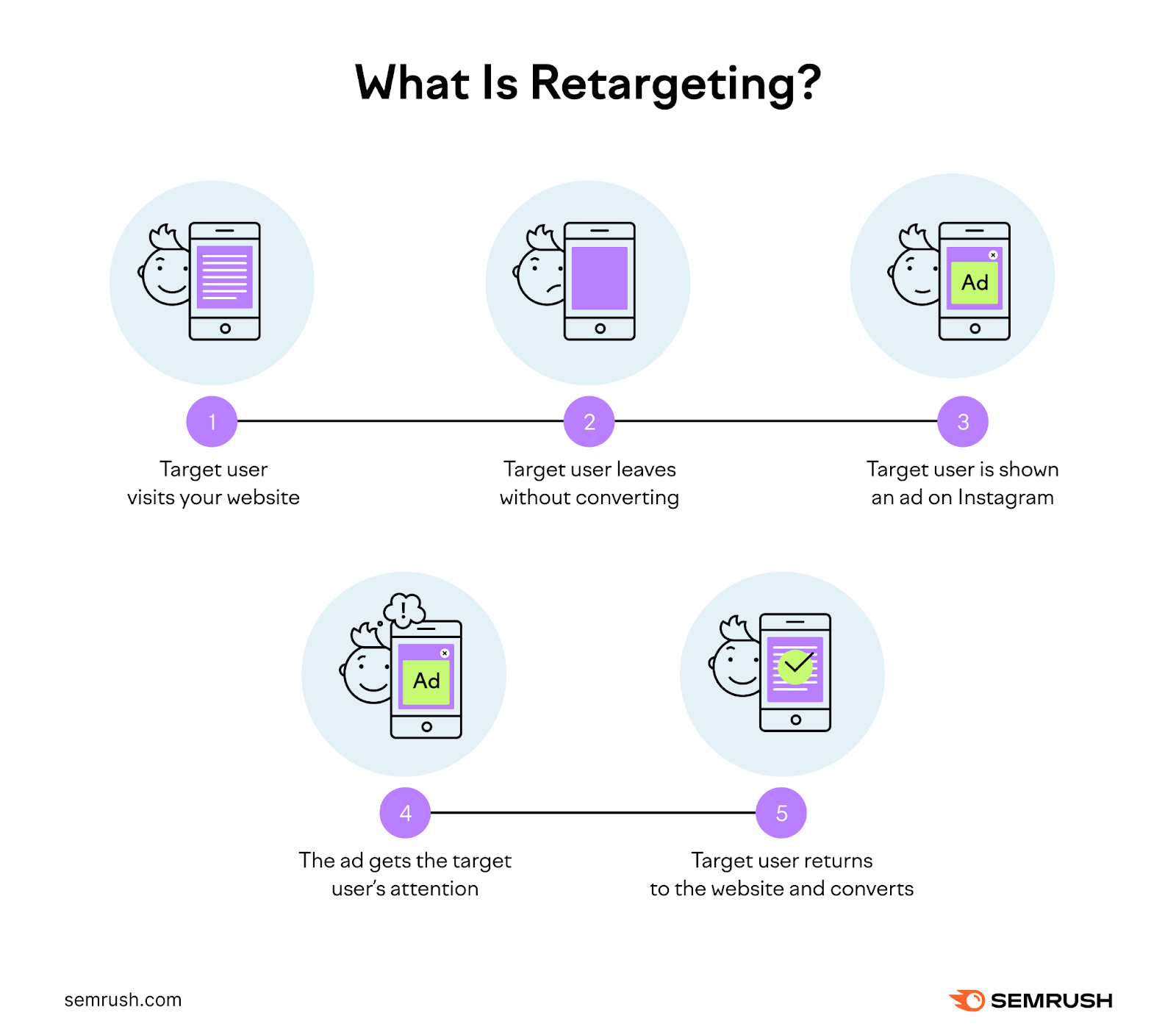
Retargeting vs. Remarketing
The terms retargeting and remarketing are often used interchangeably. But their meanings differ slightly.
Retargeting is used to reach previous site visitors through ads. And encourage them to return and complete your desired action.
Here’s an example from clothing company The Normal Brand that’s shown to users who previously visited the brand’s website without making a purchase:
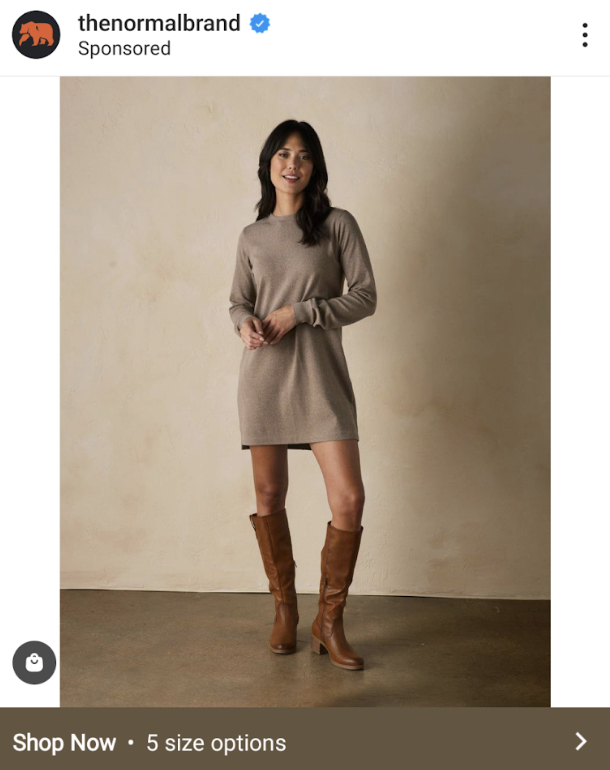
But remarketing typically refers to personalized, targeted messages sent to individuals who’ve already made a purchase. So, the primary goal of remarketing is to nurture relationships and encourage repeat purchases.
Remarketing also tends to leverage email.
For example, Grammarly sends emails with special discounts to remind existing users that they can upgrade or renew their subscription:
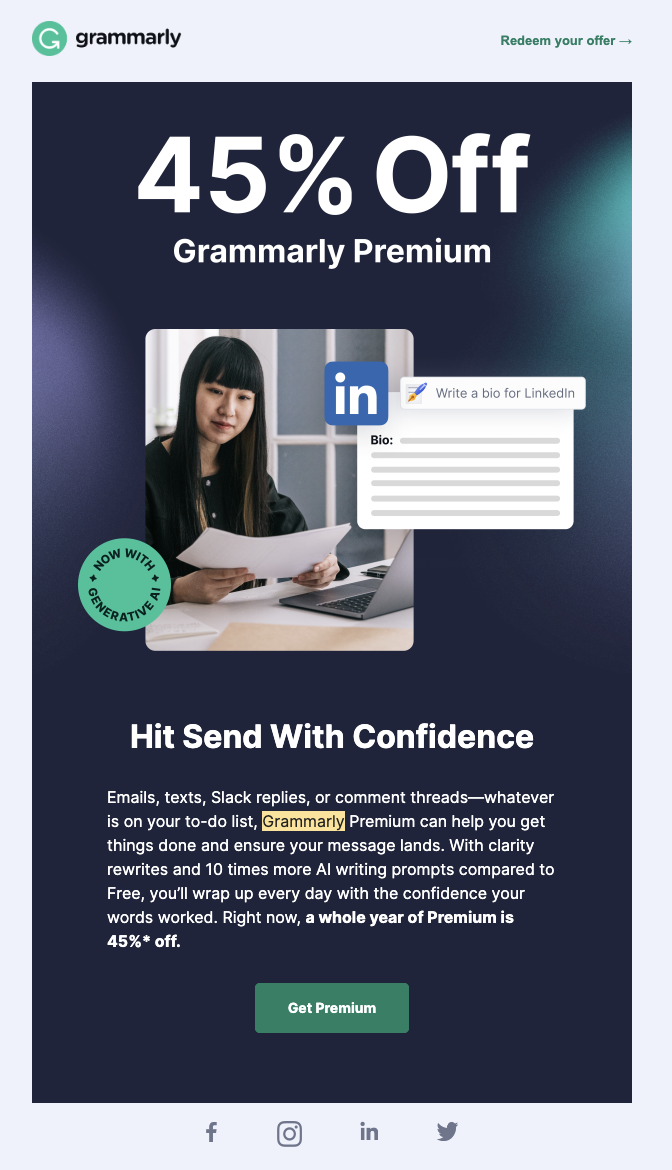
What Are the Benefits of Retargeting Campaigns?
Retargeting is beneficial because it enables you to reach out to prospects who are already familiar with your brand.
But let’s break down the benefits of running retargeting campaigns more specifically.
Driving Cost-Efficiency
Retargeting ads typically generate far better returns than ads that don’t leverage retargeting. Because they allow you to reach customers who are already familiar with you rather than starting from scratch.
Consider an Instagram ad like this that includes a discount:

People who already browsed the website for these particular shoes are going to be more receptive to this sale. And more likely to make a purchase.
Improving Brand Recall
Retargeting can help with brand recall because it provides multiple touchpoints with your target audience.
By serving a relevant ad based on users’ actions, you can gently remind them of your business and offer. Because new prospects need a bit more prompting to convert, as they may not be fully ready to purchase the first time they interact with your brand.
Promoting New or Popular Products
Retargeting can be a highly effective way to promote new or popular products. Because it targets people who’ve already shown interest in your brand.
So, these visitors may be more likely to buy from you. And that can positively affect your campaign’s return on investment (ROI).
Reaching Prospects at Every Stage of the Buyer’s Journey
Retargeting ads allow you to tailor your messages based on where the user is in their buyer’s journey.
For example, retargeting those who only viewed specific products vs. those who abandoned their cart.
This way, you can use more relevant and personalized ad creative that will prompt the user to make a purchase.
How Does Retargeting Work?
Retargeting uses tracking pixels (which Google refers to as tags) to collect information about your website visitors and prospects who engage with you on social media.
This is a piece of code provided by the advertising platform (such as Google Ads) that you place in the website header so that it loads on every page.
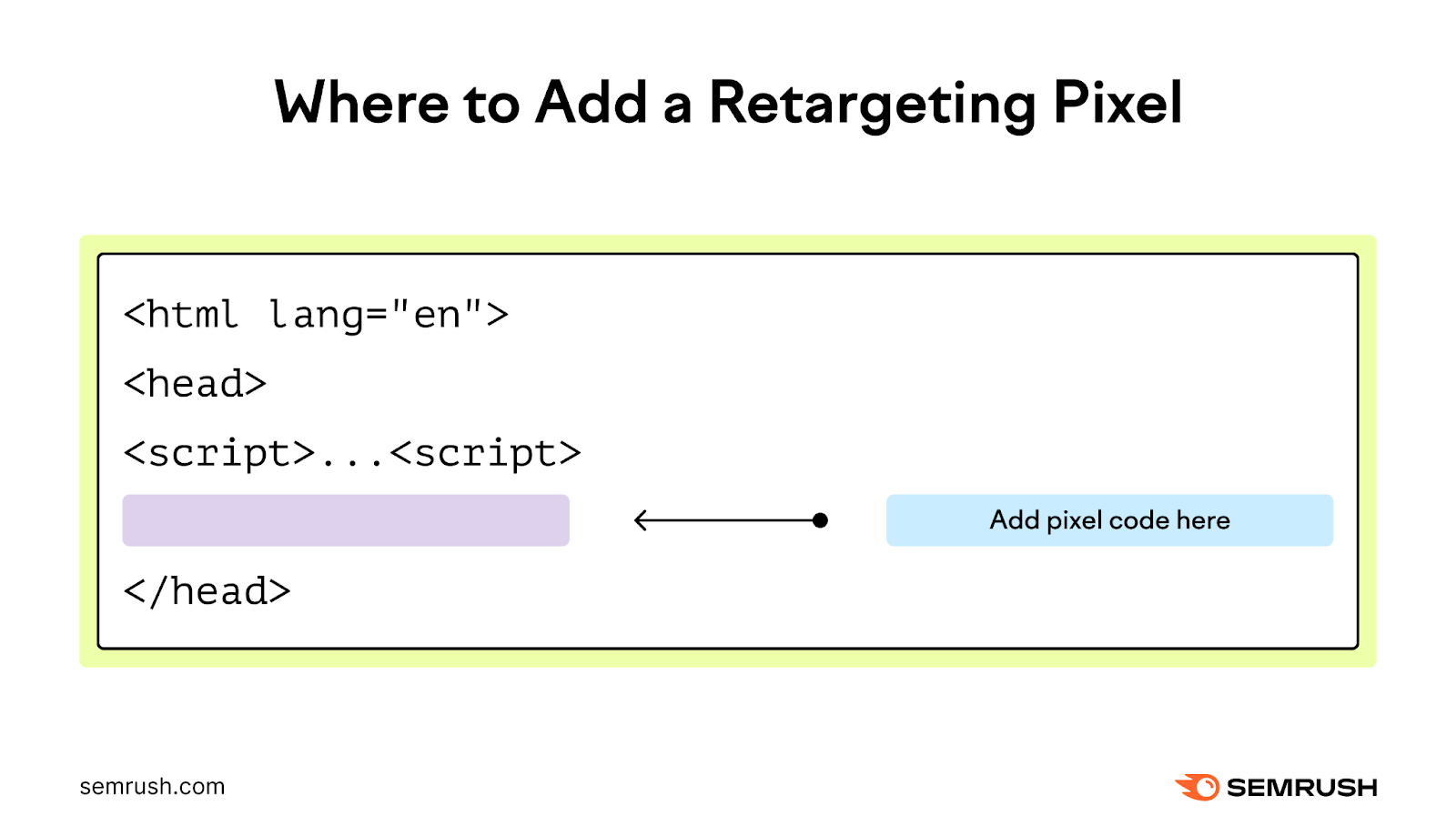
When a user visits your website, the tracking pixel is placed in their browser. This way, the advertising platform recognizes the user during visits to other websites or social media platforms where your ads can reach them.
Pixels don’t collect visitors’ personal data like names or addresses. But they record the user’s IP address, so your retargeting ads can be served to that IP address in the future.
Depending on your reporting tools, the tracking pixel can tell if a user has completed a purchase or conversion. This can help with ongoing campaigns, selling add-ons, and advertising based on previous purchases.
Beyond IP addresses, tracking pixels can monitor various user actions:
- Page views
- Clicks
- Form submissions
- Video views
- Downloads
- Add-to-carts
- Purchases
This means you can tailor your ads to better resonate with the users’ previous interactions with your brand.
Types of Retargeting Campaigns
General Website Retargeting
General website retargeting is the most common way of retargeting. It involves tracking users who’ve interacted with your website (or app) but haven’t converted.
Those actions might include viewing product pages, adding items to a cart, or initiating and abandoning the checkout process.
These retargeting ads can appear on social media and other websites. And remind users to return to your site and complete a purchase.
Search Network Retargeting
Search network retargeting ads are shown to users based on specific keywords they’ve previously searched for.
When a user searches for these keywords, your retargeting ads will follow the user around the web: on social media, other websites, as well as search engine results pages (SERPs).
For example, if a user researched online data degrees, they may see this ad the next time they’re browsing a website:

Remarketing Lists for Search Ads
Remarketing Lists for Search Ads (RLSA) is a feature from Google Ads that lets you customize your search ad campaign to reach people who’ve visited your site or app.
For instance, a user might have previously looked at a page with specific ballet flats on a shoe store’s website. Later on, while conducting a search for “comfortable ballet flats,” they may see an ad promoting those same shoes.

Top Platforms for Running Your Retargeting Ads
Here’s an overview of the most common platforms used for retargeting campaigns:
Google Ads
Google Ads is the biggest advertising platform with powerful retargeting capabilities.
It allows you to reach potential customers who’ve engaged with your website through the Google Display Network and through Google Search.
Meta Ads Manager
Meta Ads Manager lets you create and manage Facebook, Instagram, Messenger, and Meta Audience Network ads on desktop and mobile.
Meta retargeting ads use a website tracking pixel to show ads on Meta’s apps to people who have already interacted with your brand on your website or your Facebook page.
X
Retargeting ads on X (formerly Twitter) allow you to reach people who’ve engaged with your website or tweets in the past.
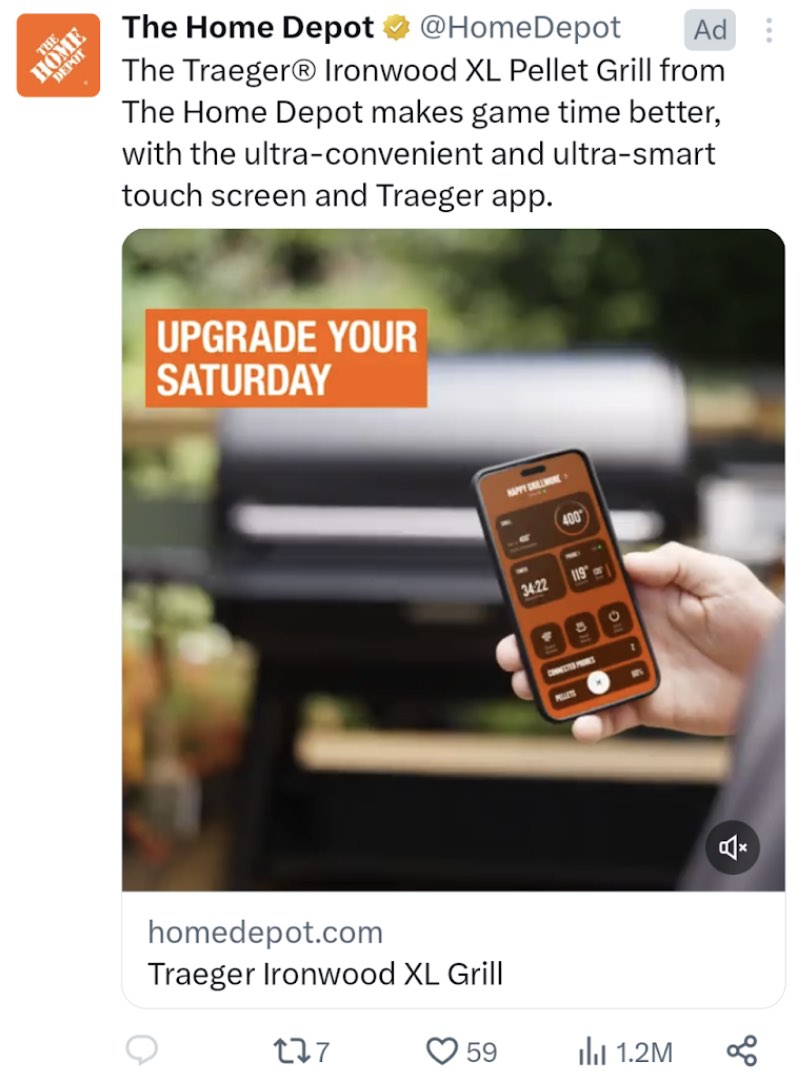
By implementing the X pixel on your website, you can deliver targeted ads.
LinkedIn retargeting ads allow you to adapt your messaging based on how users have interacted with your website, ads, or company page on LinkedIn.
You can use the LinkedIn Insight Tag on your website to retarget users, including event attendees, who haven’t converted to accelerate their buyer’s journey.
Best Practices for Creating Retargeting Ads
Create Highly Specific Ads
Your retargeting ad should always match what the user is interested in.
Say your company is a sportswear store. And one customer browses your website for shoes. And another for shorts.
Even though their interests are similar, your best option is to serve them different ads that appeal to exactly what it is they looked at on your website.
Use Landing Pages That Match the Ad
The landing page users end up on after clicking on the ad should be aligned with the ad. To keep the look and message cohesive and compel the user to buy.
Avoid sending users to your homepage or using landing pages that have too many visuals or distracting navigation links.
Instead, make a landing page that’s welcoming, clear, and product-specific.
Here’s an example.
Ad:

Ad landing page:
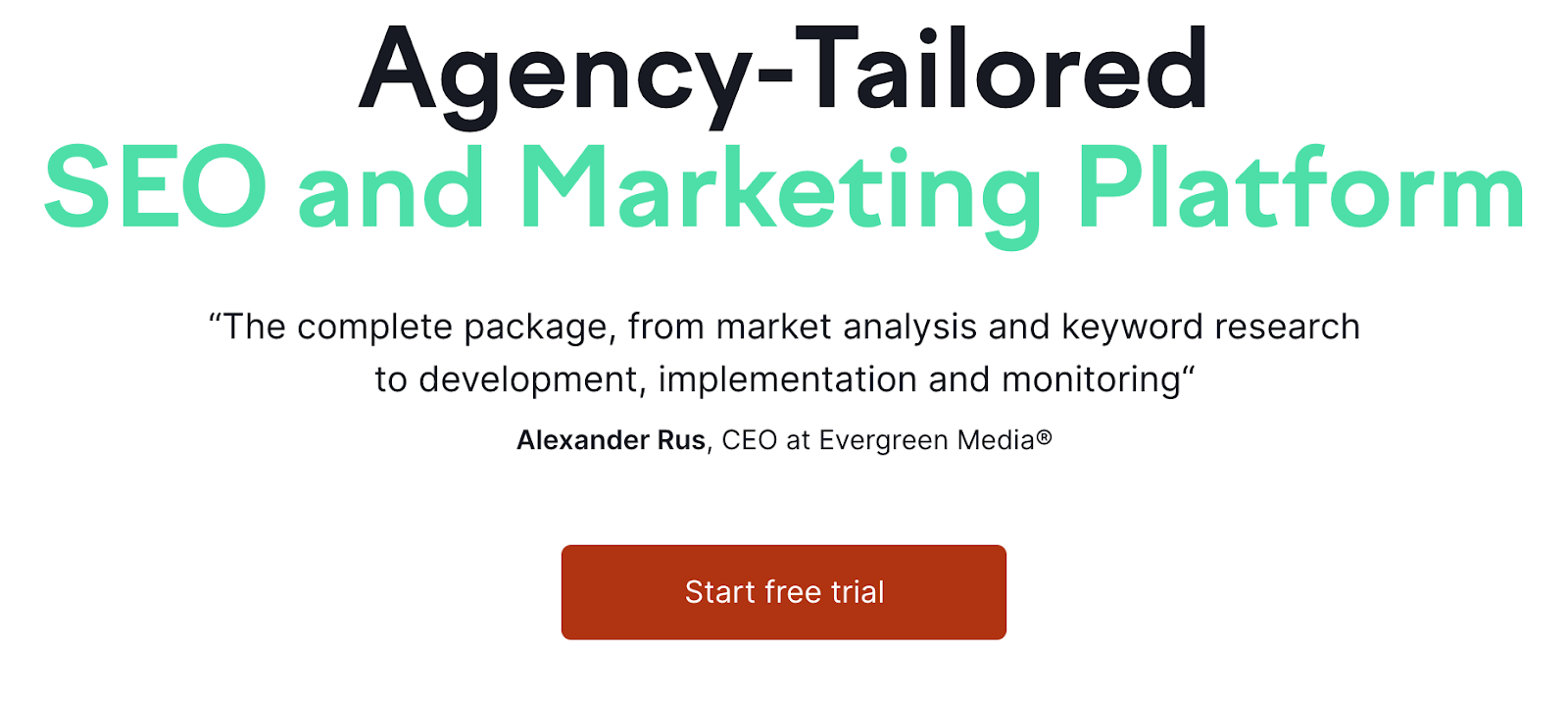
The design is clean and free of distracting elements. And there’s only one clear call to action (CTA) to start a free trial.
Optimize Your Bidding
Insufficient bidding may have a negative impact on your ad campaigns. So, make sure you’re spending enough to match up with the length of the buyer’s journey.
Because the type of product or service you’re advertising may influence how long a potential customer is interested. For example, searching for clothing can be a much shorter campaign than searching to buy a house.
That means you’d need to allocate more money for longer sales cycles.
Target the Right Audience
Make sure you only target users who are likely to be interested in your product or service.
Placing a pixel on your homepage to trigger a retargeting campaign probably isn’t a good idea. Because you don’t know what those people are interested in yet.
It’s better to create custom audiences based on specific interactions, such as product page views or adding items to the cart.
Minimize Ad Fatigue
Showing the same ad to the same users over and over can easily lead to ad fatigue.
If users keep seeing the same ad repeatedly, they may start ignoring it. Or even become annoyed.
There are a few things you can do.
One is to use ad sequencing. Which means showing a series of ads to people in a specific order to tell a story and drive interest.
Another is to set a frequency cap for your ads. This will limit the number of times an ad can be displayed to the same user within a specified time frame.
The frequency cap will help you both minimize ad fatigue and reduce ad spend. Because it will eliminate unnecessary impressions that don’t bring in clicks and conversions.
Tools for Running a Successful Retargeting Campaign
The following tools can help you bring in optimal results with your retargeting campaigns:
Traffic Analytics
Traffic Analytics from Semrush can help you learn how your competitors drive traffic to their website and which landing pages are most popular. Which can inform your retargeting campaigns.
The easiest way to get started is to add up to five competitors with the “Check Competitors” tab selected.
Then, click “Analyze.”
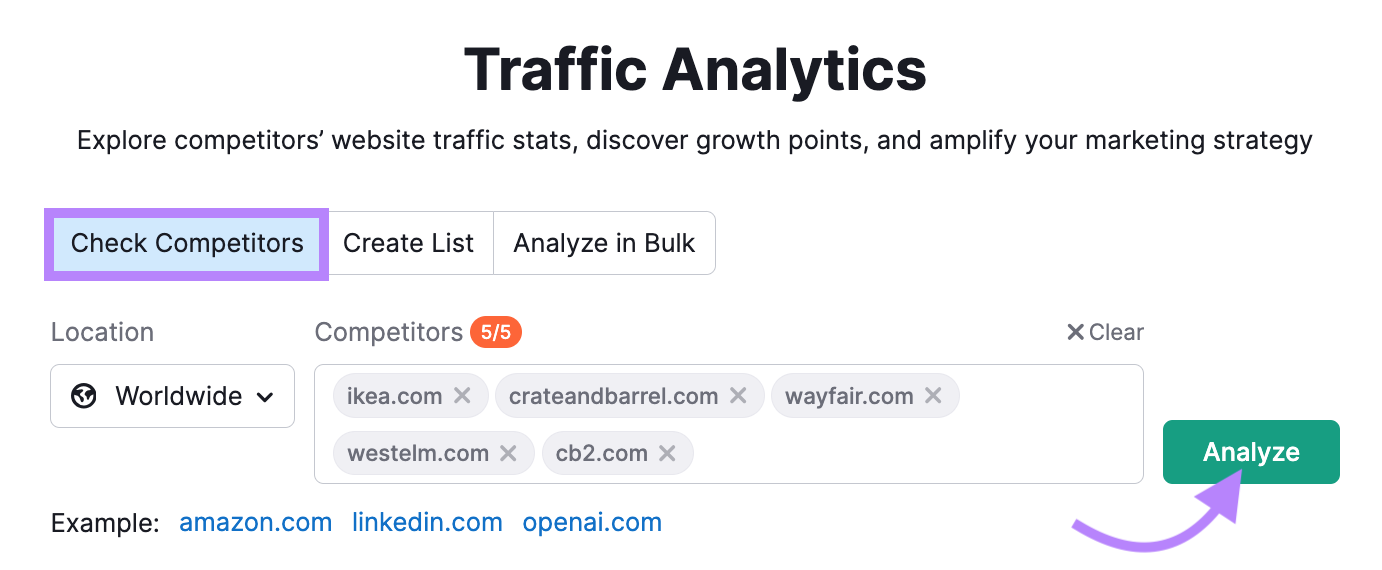
You’ll access a comprehensive report where you can see your competitors’ top traffic sources and their traffic by country.
Pay attention to which paid channels drive the most traffic to your competitors. Because those might be good options for where to focus on for retargeting campaigns.

Next, click the “Top Pages” tab to see your competitors’ most popular webpages.

You can view metrics like the number of unique visitors and the average visit duration. And even open up those pages to evaluate their messaging, imagery, and more. To get ideas for your own landing pages.
Ads Launch Assistant
Ads Launch Assistant from Semrush lets you create, launch, and optimize high-quality paid ads across Google and Meta platforms. It can help you manage retargeting campaigns with precision.
Go to Ads Launch Assistant and choose Google, Meta, or both platforms to link your ad accounts. You can create a new Google ad account within the tool if you don’t have one.
Then provide general information about your campaign. Add your business URL and optional details for AI-powered ad creation and advanced targeting options.
If you plan to launch Google Ads, you can choose its campaign type––a Search or a Smart campaign.
Next, AI will create top-quality ad copy, headlines, and UTM tags, and choose the best keywords for you.
Press “Launch campaign”.
After the launch, monitor all of your campaigns in one consolidated dashboard. You can view metrics like clicks, impressions, CPC (Cost-Per-Click), CTR (Click-through Rate), and Ad spend.
This unified reporting allows you to get insights on the best-performing creatives and apply custom optimization rules to help your campaigns perform even better.
One2Target
One2Target provides detailed insights into your market audience. These insights will help you tailor your messaging to make compelling ads that will capture your target users’ attention.
Enter your domain and one or more competitors, and click “Analyze.”
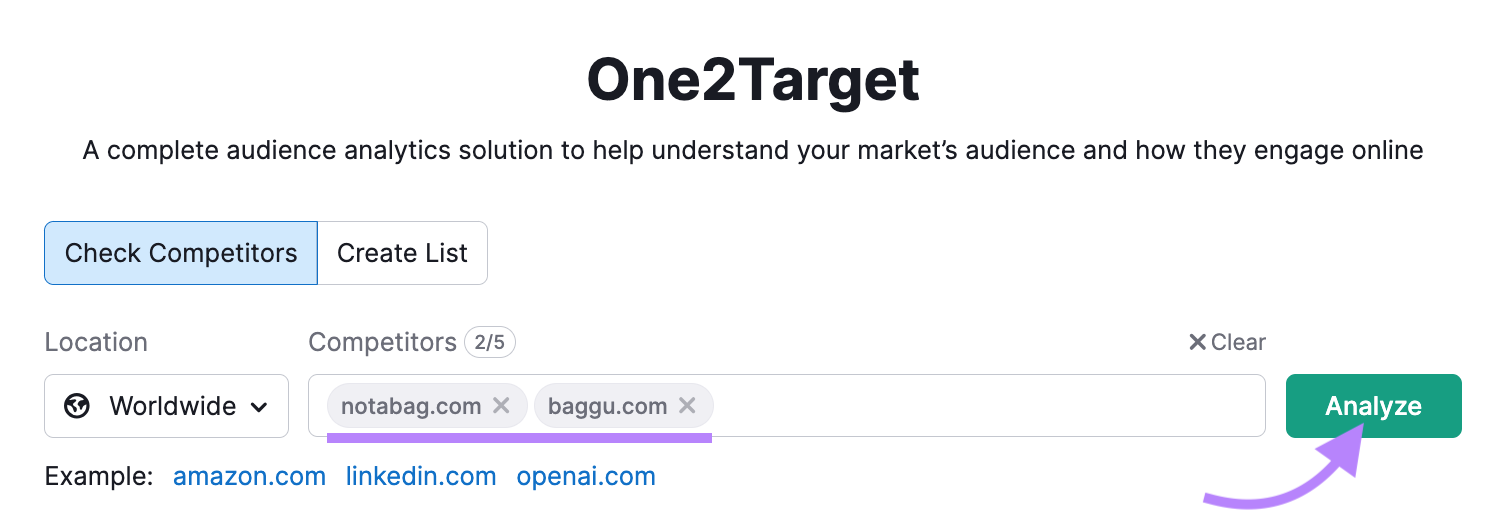
In this report, you can learn more about your target audience’s demographics, socioeconomics, behavior, and the overlap in audience between multiple competitors.
Now, go to the “Behavior” tab.
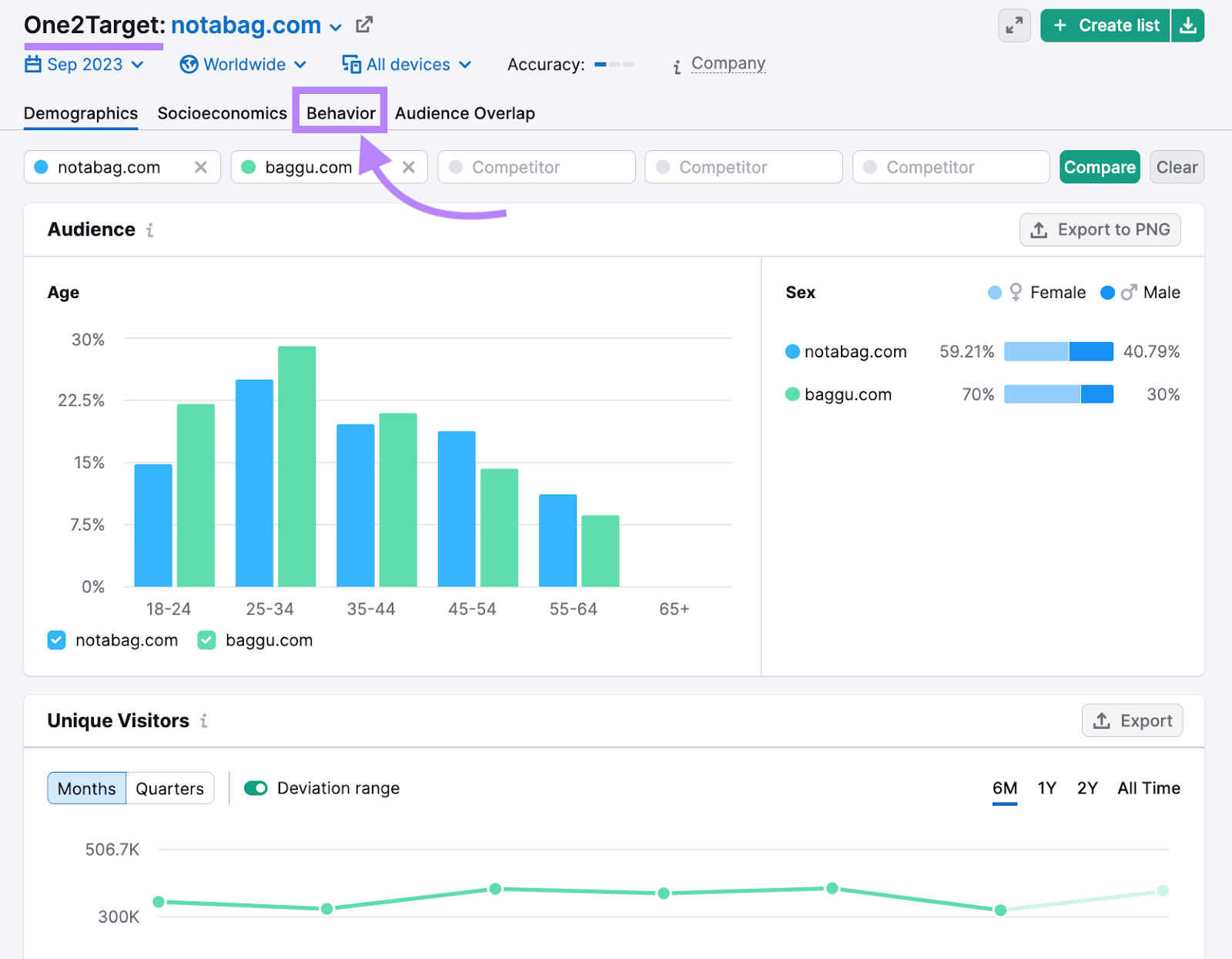
There you’ll see which social media platforms your audience visits the most and their top interests.
You can also see a breakdown of device usage. To see whether visits come mostly from mobile or desktop.
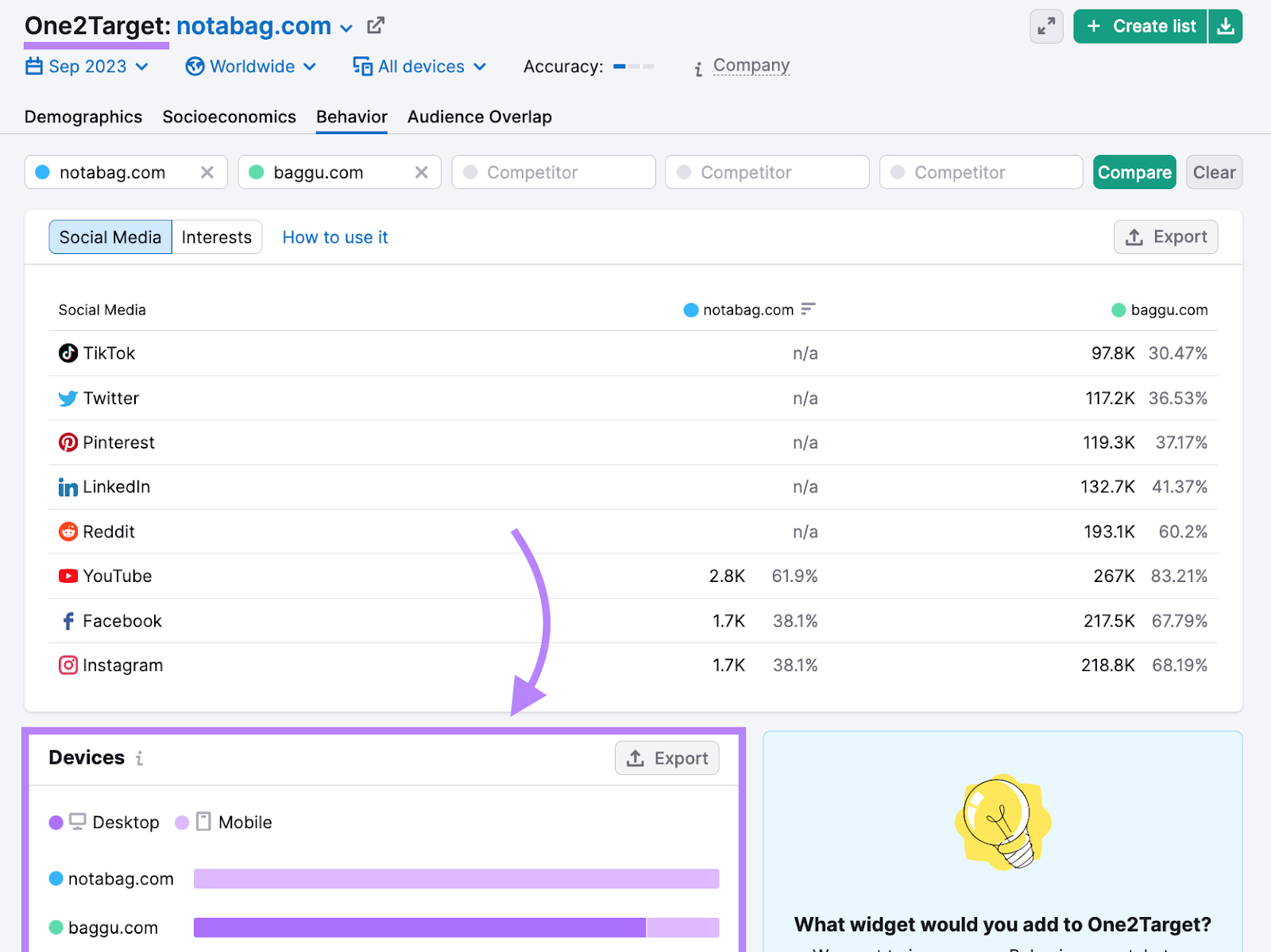
AdClarity
Use AdClarity — Advertising Intelligence to unwrap your competitors’ advertising strategies, benchmark your spend, and uncover the most profitable ad platforms and traffic sources to leverage in your next campaign.
Once you start a free trial, add a competitor’s domain. And choose the channel, device type, time range, and country you want to analyze.

You’ll see an overview of key metrics like estimated expenditure, ad type distribution, and more.

You can see summarized metrics for multiple competitors in the report below. Or you can choose the comparison view and enter one competitor, then click to submit it, and select “Compare” to enter the second competitor.
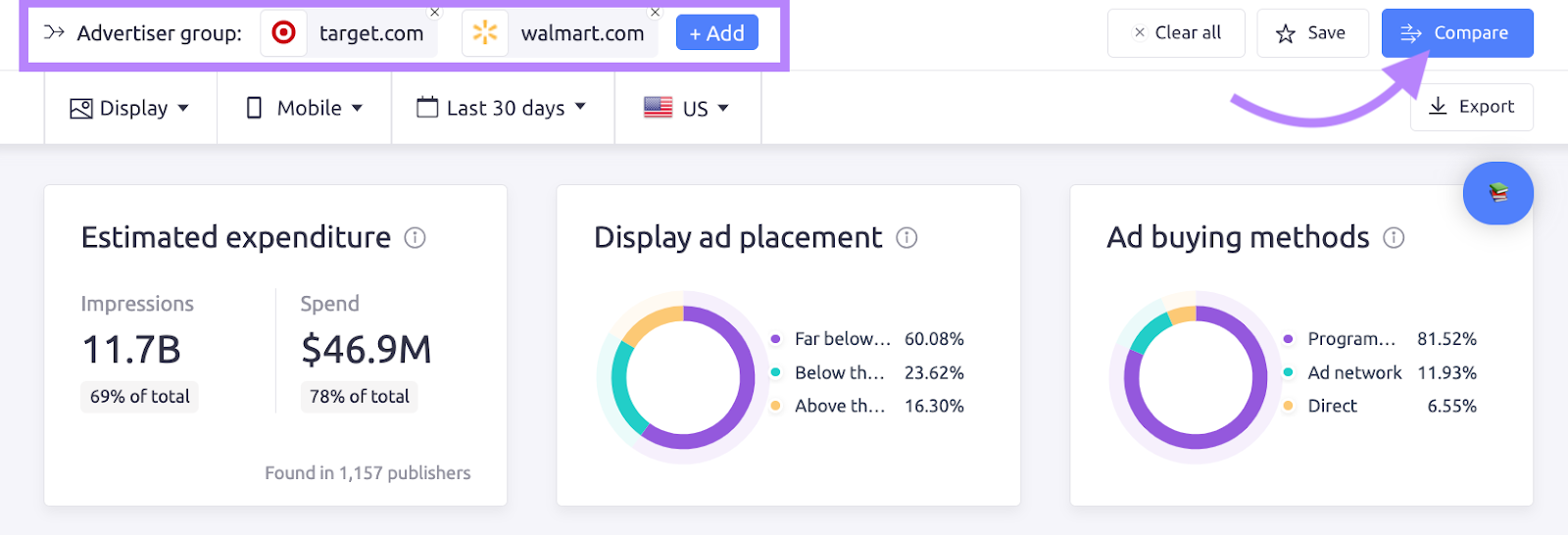
While comparing competitors, you can scroll down to the “Top Ads” widget to see their top-performing ads. Along with metrics for each.
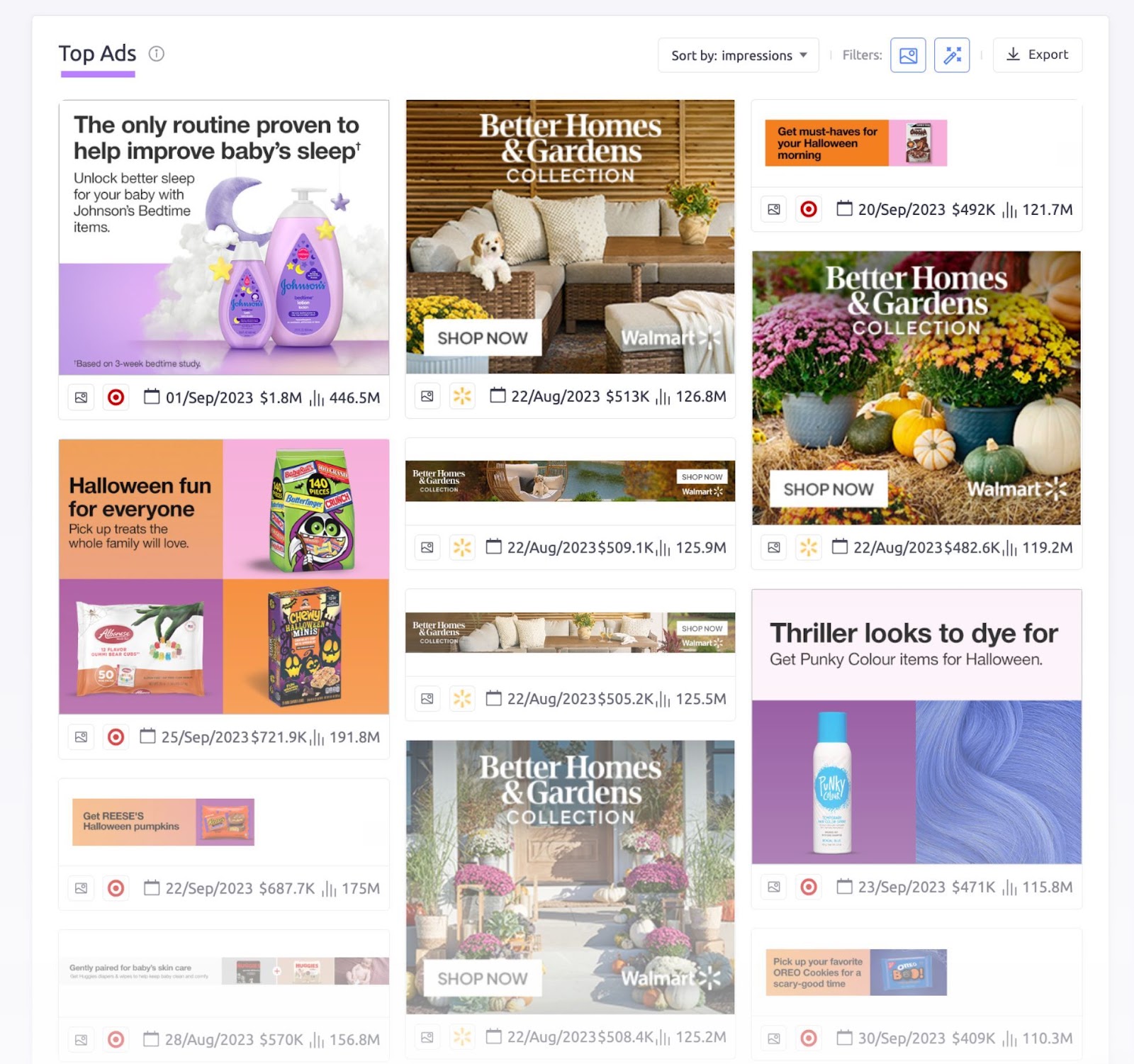
Getting deeper insights into your competitors’ ads can help you benchmark your performance and identify ways to optimize your results.
Start Leveraging Retargeting for Your Business
Retargeting in marketing is a powerful way to connect with potential customers who are already familiar with your brand and what it offers.
Before you start creating your ads and landing pages, research what your competitors have done. So you can find out what works for them and apply it to your own campaigns.
Dig into the specifics of your competitors’ landing pages with Traffic Analytics.
